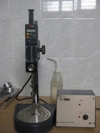 A liquid limit is one of important physical properties of a soil sample for soil classification. In principle, Atterberg limits (including liquid limit, plastic limit, shrinkage limit) must be unique and typical for each soil sample. However, in practical, the liquid limit is not unique at all and varies with the testing equipment, testing method and even the emotions of operators (!)
A liquid limit is one of important physical properties of a soil sample for soil classification. In principle, Atterberg limits (including liquid limit, plastic limit, shrinkage limit) must be unique and typical for each soil sample. However, in practical, the liquid limit is not unique at all and varies with the testing equipment, testing method and even the emotions of operators (!)
In theory, the liquid limit is the moisture content at which the soil sample changes from plastic state to liquid state. But how to determine properly this boundary between plastic and liquid states?
Nobody knows how Mr. Arthur Casagrande derived his device for liquid limit determination but this device was published in 1931 and is used commonly nowadays. Casagrande’s device operates on the ‘dynamic’ principle: a soil cup impacts on a rubber base to obtain a necessary action.

|

|
|
| Casagrande's device | Soil pat before testing |
Therefore, the liquid limit based on this device will depend on the drop height of a soil cup, the hardness of a rubber base. According to ASTM standard, the rubber base has a Type D Durometer hardness of 80~90, meanwhile the rubber base of BSI standard has a IRHD hardness of 84°~94° which is equivalent to the Type D Durometer hardness of 30~40. Consequently, which value is the real liquid limit of a soil sample?
Even worse, the researchers introduce another device for liquid limit determination based on the “static” principle: a penetrometer. The penetrometer of predefined mass will drop freely into a soil cup. The liquid limit will determine when its penetration reachs the predefined depth. The values of liquid limit based on the penetrometer will vary with the mass of penetrometer, apex angle and predefined depth. And consequently, the liquid limits obtained from penetrometers vary largely with different penetrometers.
Following table presents some of penetrometer types used in different countries.
| Apex angle | Mass of penetrometer | Predefined depth at the liquid limit | |
| England, New Zealand | 30° | 80 g | 20 mm |
| Russia, Vietnam | 30° | 76 g | 10 mm |
| Trung Quốc | 30° | 76 g | 17 mm |
| India | 30° | 148 g | 25.4 mm |
| Canada, Sweden, Norway | 60° | 60 g | 10 mm |
| Japan | 60° | 60 g | 11.5 mm |

|

|
|
| Dial gauge cone penetrometer | Electronic cone penetrometer |
Once again, the engineers and technicians are facing up the problem “which value is the real liquid limit of a soil sample?” Perhaps soil engineers should ask Mr. Arthur Casagrande for help. Waiting for his answer, geotechnicans should make clearly whenever dealing with the liquid limit: a) the device (Casagrande device or penetrometer); b) Relevant properties of a used device.













